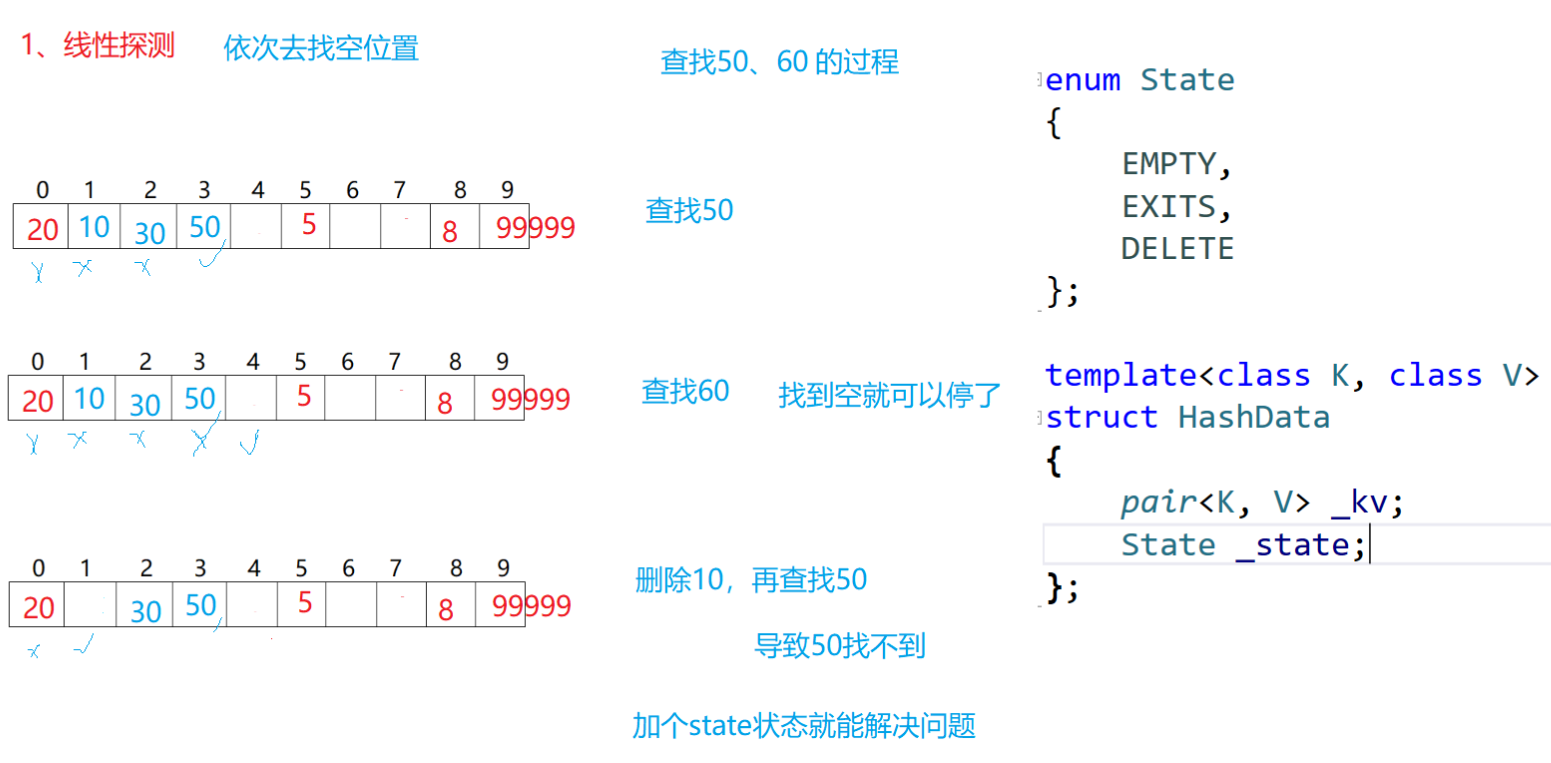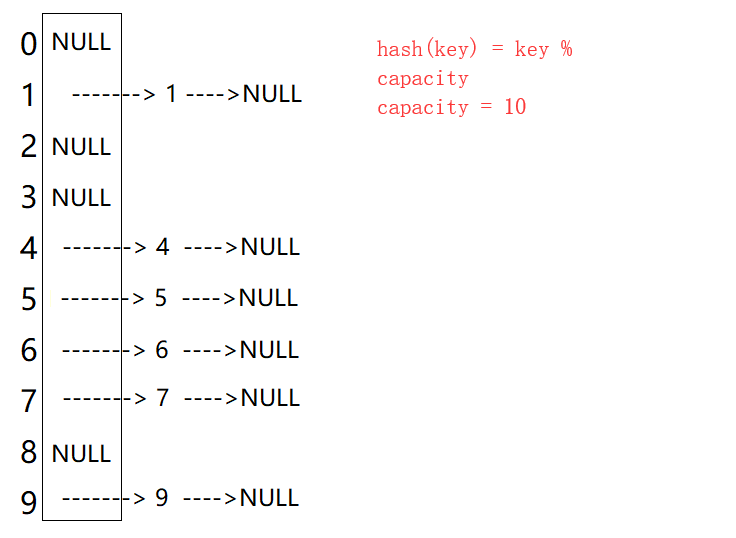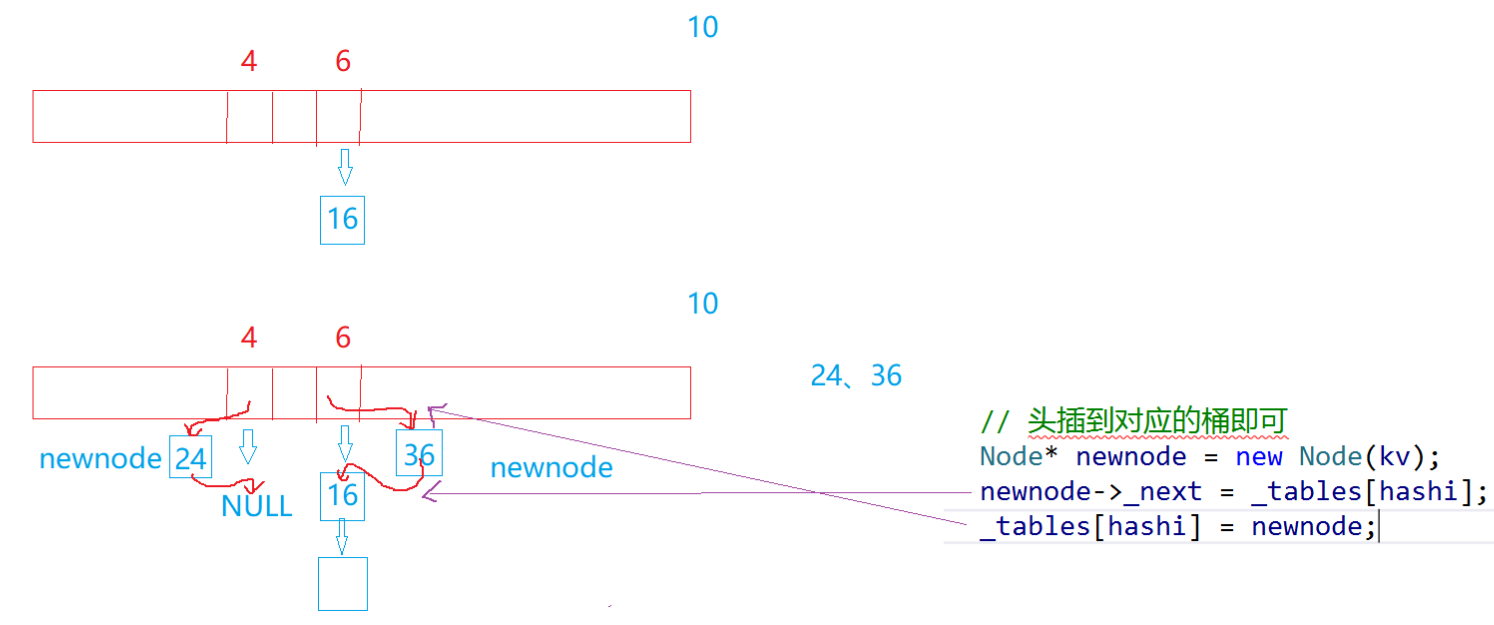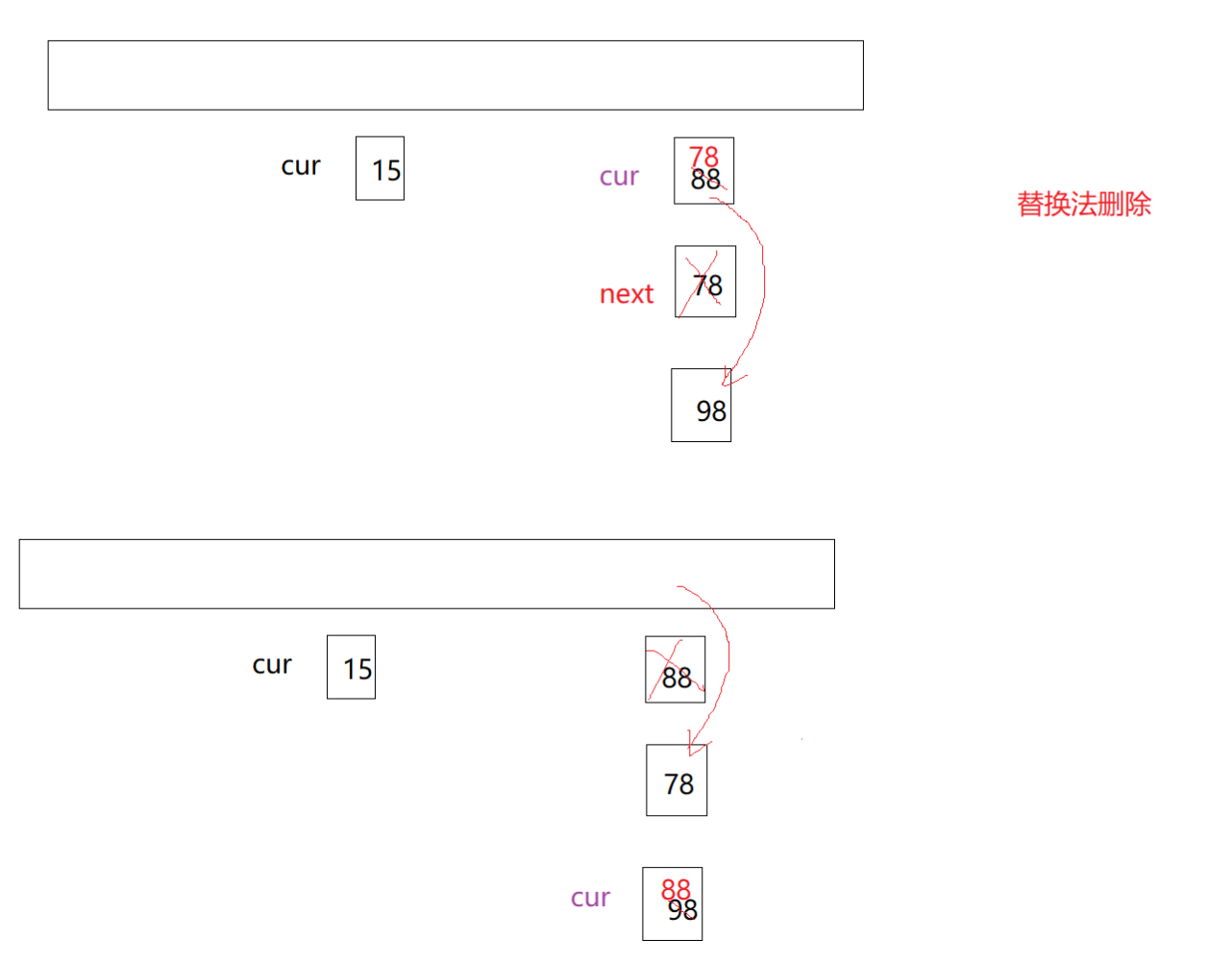1. 哈希概念
哈希也叫做散列,本质上是一种映射
顺序结构以及平衡树中,元素关键码与其存储位置之间没有对应的关系,因此在查找一个元素
时,必须要经过关键码的多次比较。顺序查找时间复杂度为O(N),平衡树中为树的高度,即
O(logn),搜索的效率取决于搜索过程中元素的比较次数。
理想的搜索方法:可以不经过任何比较,一次直接从表中得到要搜索的元素。
如果构造一种存储结构,通过某种函数(hashFunc)使元素的存储位置与它的关键码之间能够建立一一映射的关系,那么在查找时通过该函数可以很快找到该元素
假设我们直接建立映射关系,主要会产生两个问题:
- 数据范围分布很广、不集中
- key的数据不是整数,是字符串怎么办?自定义类型又怎么办?
当向该结构中:
-
插入元素
根据待插入元素的关键码,以此函数计算出该元素的存储位置并按此位置进行存放
-
搜索元素
对元素的关键码进行同样的计算,把求得的函数值当做元素的存储位置,在结构中按此位置
取元素比较,若关键码相等,则搜索成功
该方式即为哈希(散列)方法,哈希方法中使用的转换函数称为哈希(散列)函数,构造出来的结构称为哈希表(Hash Table)(或者称散列表)。
对于分布广的整型数据(负数可以先转成size_t),哈希函数可以用除留余数法–(常用)
设散列表中允许的地址数为m,取一个不大于m,但最接近或者等于m的质数p作为除数
按照哈希函数:Hash(key) = key% p(p<=m),将关键码转换成哈希地址

2. 哈希冲突
不同关键字通过相同哈希哈数计算出相同的哈希地址,该种现象称为哈希冲突或哈希碰撞。

3.哈希冲突解决
解决哈希冲突两种常见的方法是:闭散列和开散列
3.1 闭散列
闭散列:也叫开放定址法,当发生哈希冲突时,如果哈希表未被装满,说明在哈希表中必然还有
空位置,那么可以把key存放到冲突位置中的下一个空位置中去。
那如何寻找下一个空位置呢?
-
线性探测
线性探测:从发生冲突的位置开始,依次向后探测,直到寻找到下一个空位置为止。
缺点:我占了你的,你占了他的,拥堵

-
二次探测

3.2 闭散列的删除
采用闭散列处理哈希冲突时,不能随便物理删除哈希表中已有的元素,若直接删除元素会影响其他元素的搜索。因此线性探测采用标记的伪删除法来删除一个元素。

// 哈希表每个空间给个标记
// EMPTY此位置空, EXIST此位置已经有元素, DELETE元素已经删除
enum State{EMPTY, EXIST, DELETE};
3.3 闭散列的实现
思考:哈希表什么情况下进行扩容?如何扩容?

namespace CloseHash
{
enum State
{
EMPTY,
EXITS,
DELETE
};
template<class K, class V>
struct HashData
{
pair<K, V> _kv;
State _state = EMPTY;
};
template<class K>
struct DefaultHash
{
size_t operator()(const K& key)
{
return (size_t)key;
}
};
// 特化就不用传仿函数了
// 不能取地址:两个对象值相同地址不同
template<>
struct DefaultHash<string>
{
size_t operator()(const string& key)
{
// BKDR:131能有效避免哈希冲突
size_t hash = 0;
for (auto ch : key)
{
hash = hash * 131 + ch;
}
return hash;
}
};
// HashFunc将key存的数据转成size_t
template<class K, class V, class HashFunc = DefaultHash<K>>
class HashTable
{
typedef HashData<K, V> Data;
public:
bool Insert(const pair<K, V>& kv)
{
// 非multi版本去冗余
if (Find(kv.first))
{
return false;
}
// 负载因子到0.7及以上,就扩容
if (_tables.size() == 0 || _n * 10 / _tables.size() >= 7)
{
size_t newSize = _tables.size() == 0 ? 10 : _tables.size() * 2;
// 扩容以后,需要重新映射
HashTable<K, V, HashFunc> newHT;
newHT._tables.resize(newSize);
// 遍历旧表,插入newHT
for (auto& e : _tables)
{
if (e._state == EXITS)
{
newHT.Insert(e._kv);
}
}
newHT._tables.swap(_tables);
}
HashFunc hf;
size_t starti = hf(kv.first);
starti %= _tables.size();
size_t hashi = starti;
size_t i = 1;
// 线性探测/二次探测
while (_tables[hashi]._state == EXITS)
{
hashi = starti + i;
++i;
hashi %= _tables.size();
}
_tables[hashi]._kv = kv;
_tables[hashi]._state = EXITS;
_n++;
return true;
}
// 返回值不能改引用,不然无法处理空的情况,没有空引用
Data* Find(const K& key)
{
// 防止÷0错误
if (_tables.size() == 0)
{
return nullptr;
}
// 有名对象调用仿函数
HashFunc hf;
size_t starti = hf(key);
starti %= _tables.size();
size_t hashi = starti;
size_t i = 1;
while (_tables[hashi]._state != EMPTY)
{
// 防止delete了也被查找到,因为是伪删除
if (_tables[hashi]._state != DELETE && _tables[hashi]._kv.first == key)
{
return &_tables[hashi];
}
hashi = starti + i;
++i;
hashi %= _tables.size();
}
return nullptr;
}
bool Erase(const K& key)
{
Data* ret = Find(key);
if (ret)
{
ret->_state = DELETE;
--_n; // 不--会导致负载因子变大提前扩容
return true;
}
else
{
return false;
}
}
private:
vector<Data> _tables;
size_t _n = 0; // 存储关键字个数
};
void TestHT1()
{
int a[] = { 20, 5, 8, 99999, 10, 30, 50 };
//HashTable<int, int, DefaultHash<int>> ht;
HashTable<int, int> ht;
if (ht.Find(10))
{
cout << "找到了10" << endl;
}
for (auto e : a)
{
ht.Insert(make_pair(e, e));
}
// 测试扩容
ht.Insert(make_pair(15, 15));
ht.Insert(make_pair(5, 5));
ht.Insert(make_pair(15, 15));
if (ht.Find(50))
{
cout << "找到了50" << endl;
}
if (ht.Find(10))
{
cout << "找到了10" << endl;
}
ht.Erase(10);
ht.Erase(10);
if (ht.Find(50))
{
cout << "找到了50" << endl;
}
if (ht.Find(10))
{
cout << "找到了10" << endl;
}
}
void TestHT2() // 测试统计次数
{
string arr[] = { "苹果", "西瓜", "苹果", "西瓜", "苹果", "苹果", "西瓜", "苹果", "香蕉", "苹果", "香蕉" };
// 测试转换后的值是否相同
/*string s1("苹果");
string s2("果苹");
string s3("果果");
string s4("萍果");
string s5("abcd");
string s6("bcad");
string s7("aadd");
StringHash hf;
cout << hf(s1) << endl;
cout << hf(s2) << endl;
cout << hf(s3) << endl;
cout << hf(s4) << endl << endl;
cout << hf(s5) << endl;
cout << hf(s6) << endl;
cout << hf(s7) << endl;*/
//HashTable<string, int, StringHash> countHT;
HashTable<string, int> countHT;
for (auto& str : arr)
{
auto ret = countHT.Find(str);
if (ret)
{
ret->_kv.second++;
}
else
{
countHT.Insert(make_pair(str, 1));
}
}
// 对应类型配一个仿函数,仿函数对象实现把key对象转换成映射的整数
//HashTable<Date, int, DateHash> countHT;
//HashTable<Student, int, StudentHash> countHT;
HashTable<string, int> copy(countHT);
}
}
4. 开散列(哈希桶/拉链法)
数据不存在表中,表里面存储一个链表指针,冲突的数据以链表形式挂起来。
4.1 开散列概念
开散列法又叫链地址法(开链法),首先对关键码集合用散列函数计算散列地址,具有相同地址的关键码归于同一子集合,每一个子集合称为一个桶,各个桶中的元素通过一个单链表链接起来,各链表的头结点存储在哈希表中 。


从上图可以看出,开散列中每个桶中放的都是发生哈希冲突的元素。
4.2 开散列的实现

如果我们像以前一样开一个新表,把旧表的节点重新插入新表,这种方法效率是很低下的。因为新表插入得重新newnode节点,重新计算每一个节点的映射位置,还得释放旧表的节点,这是不好的。
优化:
我们没有必要去创建新的节点,可以直接把旧表的节点拿过来,但是不能像以前一样去调用insert(势必会开新节点)。简单来说就是把拷贝节点优化为转移节点。
但是析构函数还是得留下。最后一次析构得用到。
// 把仿函数放在公共区域
template<class K>
struct DefaultHash
{
size_t operator()(const K& key)
{
return (size_t)key;
}
};
// 特化就不用传仿函数了
// 不能取地址:两个对象值相同地址不同
template<>
struct DefaultHash<string>
{
size_t operator()(const string& key)
{
// BKDR:131能有效避免哈希冲突
size_t hash = 0;
for (auto ch : key)
{
hash = hash * 131 + ch;
}
return hash;
}
};
namespace Bucket
{
template<class K, class V>
struct HashNode
{
pair<K, V> _kv;
HashNode<K, V>* _next;
HashNode(const pair<K, V>& kv)
:_kv(kv)
, _next(nullptr)
{}
};
template<class K, class V, class HashFunc = DefaultHash<K>>
class HashTable
{
typedef HashNode<K, V> Node;
public:
~HashTable()
{
for (size_t i = 0; i < _tables.size(); ++i)
{
Node* cur = _tables[i];
while (cur)
{
Node* next = cur->_next;
delete cur;
cur = next;
}
_tables[i] = nullptr;
}
}
bool Insert(const pair<K, V>& kv)
{
if (Find(kv.first))
{
return false;
}
HashFunc hf;
// 负载因子 == 1 扩容
if (_tables.size() == _n)
{
// 扩容,有缺陷,可以再优化,大家下去可以思考一下
/*size_t newSize = _tables.size() == 0 ? 10 : _tables.size() * 2;
HashTable<K, V> newHT;
newHT._tables.resize(newSize, nullptr);
for (size_t i = 0; i < _tables.size(); ++i)
{
Node* cur = _tables[i];
while (cur)
{
newHT.Insert(cur->_kv);
cur = cur->_next;
}
}
newHT._tables.swap(_tables);*/
size_t newSize = _tables.size() == 0 ? 10 : _tables.size() * 2;
vector<Node*> newTable;
newTable.resize(newSize, nullptr);
for (size_t i = 0; i < _tables.size(); ++i)
{
Node* cur = _tables[i];
while (cur)
{
Node* next = cur->_next;
size_t hashi = hf(cur->_kv.first) % newSize;
cur->_next = newTable[hashi];
newTable[hashi] = cur;
cur = next;
}
_tables[i] = nullptr;
}
newTable.swap(_tables);
}
size_t hashi = hf(kv.first);
hashi %= _tables.size();
// 头插到对应的桶即可
Node* newnode = new Node(kv);
newnode->_next = _tables[hashi];
_tables[hashi] = newnode;
++_n;
return true;
}
Node* Find(const K& key)
{
if (_tables.size() == 0)
{
return nullptr;
}
HashFunc hf;
size_t hashi = hf(key);
//size_t hashi = HashFunc()(key);
hashi %= _tables.size();
Node* cur = _tables[hashi];
while (cur)
{
if (cur->_kv.first == key)
{
return cur;
}
cur = cur->_next;
}
return nullptr;
}
bool Erase(const K& key)
{
if (_tables.size() == 0)
{
return false;
}
HashFunc hf;
size_t hashi = hf(key);
hashi %= _tables.size();
Node* prev = nullptr;
Node* cur = _tables[hashi];
while (cur)
{
if (cur->_kv.first == key)
{
if (prev == nullptr)
{
_tables[hashi] = cur->_next;
}
else
{
prev->_next = cur->_next;
}
delete cur;
return true;
}
prev = cur;
cur = cur->_next;
}
return false;
//size_t hashi = key;
//hashi %= _tables.size();
//Node* cur = _tables[hashi];
//while (cur)
//{
// if (cur->_kv.first == key)
// {
// if (cur->_next == nullptr)
// {
// cur->_kv = _tables[hashi]->_kv;
// Node* first = _tables[hashi];
// _tables[hashi] = first->_next;
// delete first;
// }
// else
// {
// //....
// }
// return true;
// }
// prev = cur;
// cur = cur->_next;
//}
//return false;
}
private:
// 指针数组
vector<Node*> _tables;
size_t _n = 0;
};
void TestHT1()
{
int a[] = { 20, 5, 8, 99999, 10, 30, 50 };
//HashTable<int, int, DefaultHash<int>> ht;
HashTable<int, int> ht;
if (ht.Find(10))
{
cout << "找到了10" << endl;
}
for (auto e : a)
{
ht.Insert(make_pair(e, e));
}
ht.Erase(20);
ht.Erase(10);
ht.Erase(30);
ht.Erase(50);
// 测试扩容
ht.Insert(make_pair(15, 15));
ht.Insert(make_pair(5, 5));
ht.Insert(make_pair(15, 15));
ht.Insert(make_pair(25, 15));
ht.Insert(make_pair(35, 15));
ht.Insert(make_pair(45, 15));
}
void TestHT2()
{
int a[] = { 20, 5, 8, 99999, 10, 30, 50 };
HashTable<int, int> ht;
for (auto e : a)
{
ht.Insert(make_pair(e, e));
}
// 需要自己实现拷贝构造,完成链表桶深拷贝
//HashTable<int, int> copy(ht);
}
void TestHT3()
{
string arr[] = { "苹果", "西瓜", "苹果", "西瓜", "苹果", "苹果", "西瓜", "苹果", "香蕉", "苹果", "香蕉" };
//HashTable<string, int, StringHash> countHT;
HashTable<string, int> countHT;
for (auto& str : arr)
{
auto ret = countHT.Find(str);
if (ret)
{
ret->_kv.second++;
}
else
{
countHT.Insert(make_pair(str, 1));
}
}
}
}
4.3 开散列的删除
除了我们上面写的单链表的删除方式,我们还有另外一种方式,有点类似二叉搜索树的替换法。缺陷是最后一个节点没法找人替换,我们可以把第一个节点的值给给它,然后头删。效率没有本质的提升,只是提供另一个思路。

bool Erase(const K& key)
{
if (_tables.size() == 0)
{
return false;
}
HashFunc hf;
size_t hashi = hf(key);
hashi %= _tables.size();
Node* prev = nullptr;
Node* cur = _tables[hashi];
while (cur)
{
if (cur->_kv.first == key)
{
if (prev == nullptr)
{
_tables[hashi] = cur->_next;
}
else
{
prev->_next = cur->_next;
}
delete cur;
return true;
}
prev = cur;
cur = cur->_next;
}
return false;
}
private:
// 指针数组
vector<Node*> _tables;
size_t _n = 0;
};
后一个节点没法找人替换,我们可以把第一个节点的值给给它,然后头删。效率没有本质的提升,只是提供另一个思路。
[外链图片转存中…(img-Is2BHC9n-1662947354925)]
bool Erase(const K& key)
{
if (_tables.size() == 0)
{
return false;
}
HashFunc hf;
size_t hashi = hf(key);
hashi %= _tables.size();
Node* prev = nullptr;
Node* cur = _tables[hashi];
while (cur)
{
if (cur->_kv.first == key)
{
if (prev == nullptr)
{
_tables[hashi] = cur->_next;
}
else
{
prev->_next = cur->_next;
}
delete cur;
return true;
}
prev = cur;
cur = cur->_next;
}
return false;
}
private:
// 指针数组
vector<Node*> _tables;
size_t _n = 0;
};